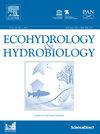不同红树林沼泽中的生境因素、营养负荷和浮游生物群落结构之间的关系
IF 2.2
4区 环境科学与生态学
Q2 ECOLOGY
引用次数: 0
摘要
人们普遍认为,红树林可以再生并向邻近的生境(包括海水)输出营养物质。然而,一直有说法认为尼帕棕榈沼泽是尼日尔三角洲营养物质流失的栖息地,尽管很少得到证实——棕榈的凋落叶状况不佳,凋落叶难降解,分解缓慢。本研究比较了尼日尔三角洲东部伊莫河下游绕道科诺溪的原生红树保护区和尼帕棕榈林的营养(硝酸盐和磷酸盐)水平和浮游生物组合的变化。在6个月内(2017年1月- 2017年6月)采集48份水样进行营养分析。本研究提供了两个红树林区系景观中硝酸盐和磷酸盐水平的基本基线数据。在复合氮磷比为7.2:1的情况下,尼帕棕榈林的硝酸盐含量较高,而原生红树林沼泽的磷酸盐含量最高。然而,两种营养物质均无显著差异(P >;0.05),分布在不同的采样地点以及涨潮和退潮之间。尼帕棕榈沼泽浮游植物个体数量较多,但物种丰富度和多样性较低。红树林湿地浮游动物个体数量较多,物种丰富度和多样性较高。我们推测,研究地点的邻近性、潮汐分布以及微藻和大藻养分消耗的空间偏斜是生境空间养分等价的驱动因素。无法确定本地红树和尼帕棕榈沼泽是硝酸盐和磷酸盐的汇还是出口。因此,对这两种沿海沼泽森林的养分更新和输出率的变化进行实验调查将有助于了解这一点。讨论了原生红树林因人类活动而萎缩的地区对初级生产力和环境监测的影响。本文章由计算机程序翻译,如有差异,请以英文原文为准。
Relationship between habitat factors, nutrient loads, and plankton community structure in varied mangrove swamps
It is widely acknowledged that mangroves regenerate and export nutrients to adjacent habitats, including marine waters. However, there are persisting claims, though less verified, that nipa palm swamps are nutrient-sapping habitats in the Niger Delta—that the palm has a poor leaf litter regime and refractory, slow-decomposing litter. This study compared variations in nutrient (nitrate and phosphate) levels and the plankton assemblages in a native red mangrove reserve and nipa palm forest in Kono Creek, a bypass of the lower reach of the Imo River in the eastern Niger Delta. Forty-eight water samples for nutrient analysis were collected for six months (January 2017–June 2017). This study provided essential baseline data on nitrate and phosphate levels in two mangrove floristic landscapes. With a composite N: P ratio of 7.2:1, relatively higher nitrate concentrations were recorded in the nipa palm forest, while phosphate values were highest in the native mangrove forest swamp. However, neither of the nutrients showed any significant difference (P > 0.05) across the sampled locations and between flood and ebb waters. Phytoplankton in the nipa palm swamp had relatively more individuals but less species richness and diversity. In contrast, zooplankton were represented by more individuals and had higher species richness and diversity in the conserved red mangrove swamp. We hypothesize that the proximity of the studied sites, tidal distribution, and skewed spatial microalgae and macroalgae nutrient consumption are among the spatial nutrient equivalence habitat drivers. It was impossible to determine whether the native red mangrove and nipa palm swamps were sinks or exporters of nitrate and phosphate. Thus, experimental investigations into the variations in the nutrient regeneration and export rates for both coastal swamp forests would provide insight into this. The implications for primary productivity and environmental monitoring in regions where native mangroves are shrinking due to human activities are discussed.
求助全文
通过发布文献求助,成功后即可免费获取论文全文。
去求助
来源期刊

Ecohydrology & Hydrobiology
Agricultural and Biological Sciences-Aquatic Science
CiteScore
5.40
自引率
3.80%
发文量
51
期刊介绍:
Ecohydrology & Hydrobiology is an international journal that aims to advance ecohydrology as the study of the interplay between ecological and hydrological processes from molecular to river basin scales, and to promote its implementation as an integrative management tool to harmonize societal needs with biosphere potential.
 求助内容:
求助内容: 应助结果提醒方式:
应助结果提醒方式:


